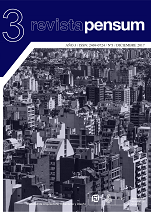PREDICTION OF ACOUSTICS PARAMETERS IN JESUIT CHURCHES IN CORDOBA AND SAN IGNACIO MINI.
DOI:
https://doi.org/10.59047/2469.0724.v3.n3.19023Keywords:
Ways of Living, Project Processes, Domestic SpaceAbstract
Throughout what is now the territory of Argentina they were settled, during the period of Spanish domination, colonies founded and built by Jesuit priests, in order to "evangelize" the natives. For many years these colonies were centers of production and culture that spread to the rest of the territory. The priests preached and learned local languages through which they communicated. His concern for the understanding of speech, and through them it is manifested in the temples they built. This research analyzes the influence of this thought, translated to the churches acoustics in the colonies, evaluating the parameters that determine the understanding of speech; and the ability of each of the churches to sing religious music. In those cases where the temples fell apart or part of it, modeling and auralization was used to reconstruct the sound inside the churches and recover the intangible cultural heritage.References
Arau, H. (1999). ABC de la Acústica Arquitectónica. Barcelona: CEAC.
Arau, H. (2008). ¿Es el criterio acústico el paradigma de la excelencia acústica en el diseño de salas? Acústica.
Barrio Mora, J. (2008). Sistema de predicción de parámetros que caracterizan el campo sonoro en iglesias (Tesis doctoral). Universidad Politécnica de Madrid, Madrid.
Barron, M. (1988). Subjective Study of British Symphony Concert Halls. Acústica, 66 (1).
Beranek, L. (2003). Concert Halls and Opera Houses: Music, Acoustics, and Architecture (2a. ed.). New York (USA): Springer Science & Business Media.
Carrion Isbert, A. (1998). Diseño acústico de espacios arquitectónicos. Cataluña: UPC.
Carvalho, A. P. (1994). Relationship between objective acoustical measures and architectural features in churches. In 127th Acoustical Society of America Meeting (pp. 311–314). Cambridge, USA.
Carvalho, A. P. (2001). Church Acoustics and Influence of Occupancy. Building Acoustics, 9, pp. 29–47.
Carvalho, A. P., Morgado, A. E., & Henrique, L. (1997). Relationship between Subjective and Objective Acoustical Measures in Churches. Building Acoustic, 4 (1), pp. 1–20.
Cirilo, E., & Martellotta, F. (2003). Acoustics of Apulian-Romanesque Churches: Correlations between
Architectural and Acoustic Parameters. Building Acoustics, 10 (1), pp. 55–76.
Farina, A. (2001). Acoustic quality of theatres: correlations between experimental measures and subjective evaluations. Applied Acoustics, 62, 889.
Jiménez Dianderas, C. (2010). Correlación entre parámetros acústicos objetivos y características físico arquitectónicas en templos católicos del período colonial en ciudades representativas del Perú (Tesis doctoral). Universidad Politécnica de Madrid, Madrid.
Knudsen, V., & Harris, C. (1988). Acoustical Design in Architecture (5a. ed.). New York (USA): Acoustical Society of America.
Martellotta, F., Cirillo, E., Carbonari, A., & Ricciardi, P. (2009). Guidelines for acoustical measurements in churches. Applied Acoustics, 70, pp. 378–388.
Ottobre, D. (2006). Base de datos para el análisis y comparación de parámetros acústicos y psicoacústicos en teatros y salas de concierto (Tesis doctoral). Universidad Politécnica de Madrid, Madrid.
Raes, A. (1953). Measurements of the Acoustical Properties of Two Roman Basilicas. Journal of the Acoustical Society of America, 25, 925–961.
Recuero López, M. (1999). Acústica arquitectónica aplicada. Madrid (España): Paraninfo.
Recuero López, M. (2003). Contaminación Acústica (Tesis de licenciatura). Universidad Politécnica de Madrid, Madrid.
Schroeder, M. R. (1965). New Method of Measuring Reverberation Time. Journal of the Acoustical Society of America, 37, pp. 409–412.
Sendra, J.J. y Navarro Casas, J. (1996). El concilio de Trento y las condiciones acústicas de las iglesias. In Actas del Primer Congreso Nacional de Historia de la Construcción (pp. 19–21). Madrid.
UNE-EN ISO 3382 (2010).
Zamarreño, T., Girón, S., & Galindo, M. (2011). Simulación acústica y virtualización en recintos de culto. Presented at the Interrnational Seminar on Virtual Acoustics, Valencia.
Downloads
Published
Issue
Section
License
Authors who publish in this journal agree to the following terms:
a. Authors retain copyright and guarantee to the journal the right to be the first publication of the work as well as licensed under a Creative Commons Attribution-ShareAlike 4 license.
b. Authors may separately establish additional agreements for non-exclusive distribution of the version of the work published in the journal (e.g., placing it in an institutional repository or publishing it in a book), with an acknowledgement of its initial publication in this journal.
c. Authors are permitted and encouraged to disseminate their work electronically (e.g., in institutional repositories or on their own website) before and during the submission process, as this may result in productive exchanges, as well as earlier and greater citation of published work (See The Effect of Open Access).
d. 4.0 International Creative Commons Attribution-ShareAlike 4.0 License.












